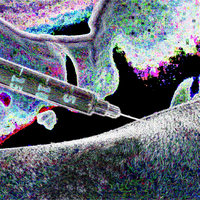| Amphetamine | |
|---|---|
| Salts [] | |
|---|---|
| Chlorphenoxyacetate | |
| Sulfate | |
| Hydrochloride | |
| Aspartate | |
| Adipate | |
| Tartrate | |
| Phosphate | |
| Saccharate | |
| Succinate | |
| Molecular structure via molpic based on CDK |
| Conformer [] | |
|---|---|
| Conformer structure via JSmol | |
| Physical properties [] | |
|---|---|
| Molecular mass | 135.21 g/mol [1] |
| Density | 0.913 at 77 °F (EPA, 1998) - Less dense than water; will float g/cm3 [1] |
| Appearance | Mobile liquid [1] |
| Odor | Amine odor [1] |
| Taste | Acrid, burning taste [1] |
| Melting point | 25 °C [1] |
| Boiling point | 392 to 397 °F at 760 mmHg (EPA, 1998) [1] |
| Decomposition | When heated to decomposition it emits toxic fumes of nitroxides. [1] |
| Solubility | Moderate solubility [1] |
| Predicted LogP | 1.8 [1] |
| Structural Identifiers [] | |
|---|---|
| Molecular formula | C9H13N [1] |
| IUPAC name | 1-phenylpropan-2-amine [1] |
| SMILES | CC(CC1=CC=CC=C1)N [1] |
| InChI | InChI=1S/C9H13N/c1-8(10)7-9-5-3-2-4-6-9/h2-6,8H,7,10H2,1H3 [1] |
| InChIKey | KWTSXDURSIMDCE-UHFFFAOYSA-N [1] |
| Toxicity [] | |
|---|---|
| LDLo | Rat: - intraperitoneal: 23 mg/kg - intravenous: 20 mg/kg Dog: - subcutaneous: 20 mg/kg Monkey: - subcutaneous: 20 mg/kg Rabbit: - subcutaneous: 20 mg/kg - intravenous: 25 mg/kg Guinea pig: - oral: 200 mg/kg - subcutaneous: 20 mg/kg - parenteral: 20 mg/kg |
| LD50 | Rat: - oral: 30 mg/kg - subcutaneous: 180 mg/kg Mouse: - oral: 21 mg/kg - intraperitoneal: 5500 μg/kg - subcutaneous: 15 mg/kg - intravenous: 15 mg/kg Mammal (species unspecified): - oral: 135 mg/kg - intraperitoneal: 65 mg/kg |
Amphetamine
Amphetamine (also known as Amphetamine, Amfetamine, Desoxynorephedrine, Norephedrane, 1-Phenyl-2-aminopropane, Elastonon, Fenopromin, Phenedrine, β-Aminopropylbenzene or Propisamine) is a stimulant substance of the amphetamine class.
Chemistry
Salts []
Amphetamine is typically found in the form of its chlorphenoxyacetate, sulfate, hydrochloride, aspartate, adipate, tartrate, phosphate, saccharate and succinate salts.
Stereochemistry []
Amphetamine is a racemic mixture of the enantiomers
| Stereoisomers |
|---|
Subjective effects
| Anodyne Usernotes [] | |
|---|---|
| 0xea / Amphetamine[freebase][sulfate][hydrochloride] via Oral, Insufflated, Intrarectal, Subcutaneous, Intramuscular, Intravenous, Inhaled, Vaporized and Sublingual | Moderate Stimulation; Moderate Euphoria; Strong Vasoconstriction; Practical via Intravenous Injection, 1 minute comeup 3-4 hour duration; Practical via Subcutaneous Injection 25 minute comeup |
Experience reports []
There are currently 6 experience reports involving amphetamine on OpenErowid:
See also []
External links []
References []
National Center for Biotechnology Information. PubChem Compound Summary for CID 3007, Amphetamine. Accessed August 7, 2025. https://pubchem.ncbi.nlm.nih.gov/compound/3007
U.S. Food and Drug Administration; National Center for Advancing Translational Sciences. Amphetamine. UNII: CK833KGX7E. Global Substance Registration System. Accessed August 7, 2025. https://gsrs.ncats.nih.gov/ginas/app/beta/substances/CK833KGX7E
 Anodyne
Anodyne